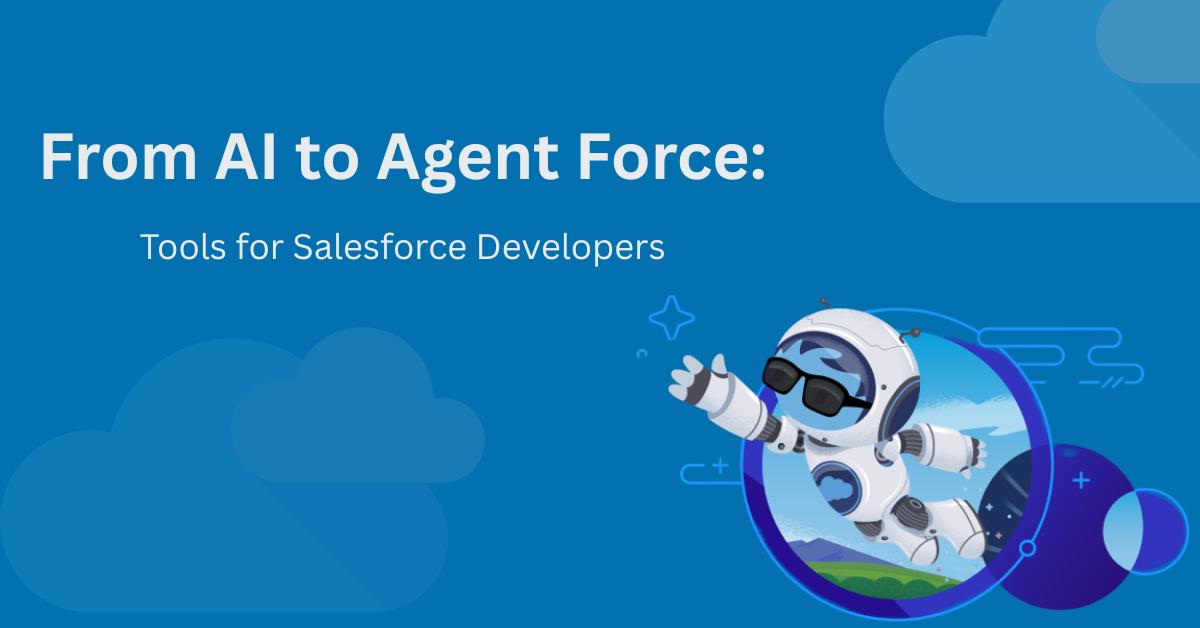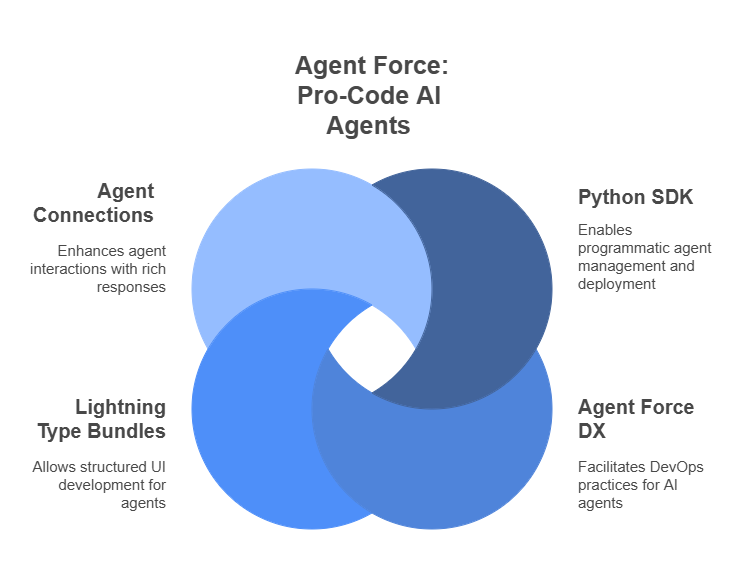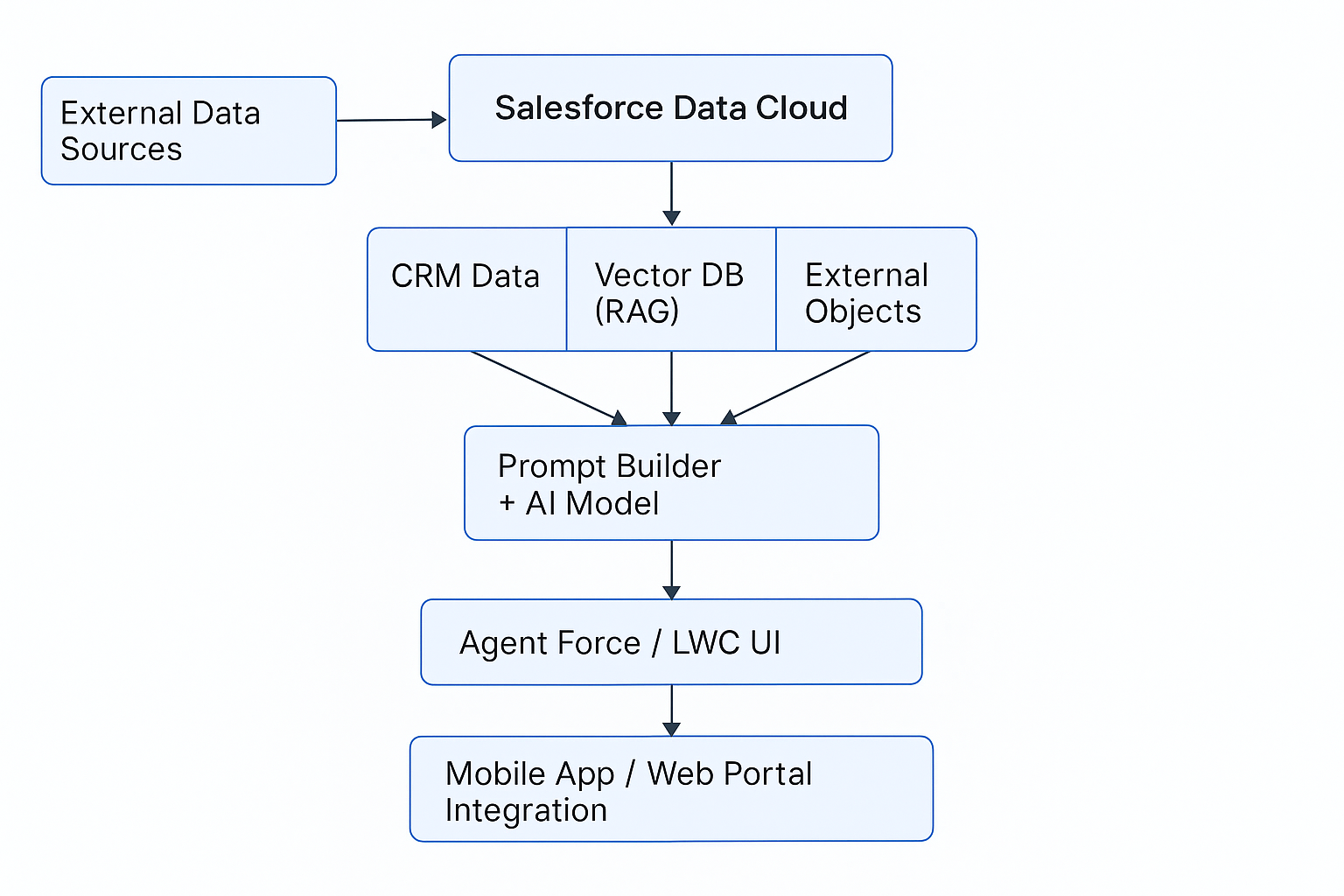New in Salesforce Summer’25: A Developer’s Guide to Building with AI, Agent Force, and Data Cloud
Supercharge development with Salesforce AI

Salesforce’s Summer ’25 Release marks a transformative leap forward in how developers build intelligent, scalable, and future-ready solutions. With cutting-edge enhancements in Agent Force, Data Cloud, Apex, Lightning Web Components (LWCs), and APIs, this release has tools that empower pro-code workflows and enterprise-grade AI integrations.
As a digital transformation partner, Info Services deeply delves into the most impactful updates and how enterprises can start building next-gen experiences powered by generative AI, data intelligence, and developer-first architecture.
Agent force: Powering Pro-Code AI Agents
Agent force is Salesforce's framework for building AI-driven agents operating across support, sales, and self-service experiences. With Summer ’25, Agent Force is now a developer's playground, with Python SDK, DX support, and Lightning-based UI tools.
1. Python SDK for Agent Development
Salesforce now offers a Python SDK to allow developers to:
- Programmatically define, test, and manage AI agents
- Create prompt templates in code.
- Work with JSON-based agent definitions for easy deployment and versioning.
Why it matters: This unlocks pro-code AI agent development, which is no longer limited to UI builders. Developers can use Git, CI/CD pipelines, and familiar Python environments to automate and scale intelligent agents.
Use case for enterprises: Using a fully customizable, secure approach, enterprises can automate customer queries, create smart assistants for field reps, or deploy AI for compliance checks.
2. Agent force DX (Beta): DevOps for AI Agents
The Salesforce DX Beta integration means you can now:
- Embed AI agents into your Salesforce CLI and VS Code projects
- Version, test, and deploy agents like any other Salesforce component.
- Work collaboratively across teams with GitOps.
Enterprise impact: AI becomes a first-class citizen in your Salesforce DevOps pipeline. This is perfect for teams working with large orgs and multiple sandboxes.
3. Lightning Type Bundles (Developer Preview)
With Lightning Type Bundles, developers can define:
- Structured UIs for agents
- Custom renderers and editors
- Support for advanced schema validation
This allows developers to build responsive, intelligent UIs that adapt to the AI agent’s logic.
4. Agent Connections (Beta): Smarter Conversations
Agents can now deliver:
- Rich responses, such as quick links, buttons, and action choices
- Context-aware guidance in chat and digital channels
Why it’s exciting :It brings Chat GPT-like functionality into Salesforce in a brand-safe, enterprise-controlled environment

Agent Force isn’t just a developer toolset-it’s a strategic leap toward autonomous, AI-powered CRM. With its ability to integrate business data, user context, and task automation, Agent Force enables organizations to build intelligent agents that operate across support, sales, and self-service workflows. As enterprises begin embedding AI into every customer interaction, Agent Force stands at the intersection of generative AI, workflow orchestration, and secure enterprise deployment.

External Objects in Prompt Builder: Grounded AI with Real-Time Data
A game-changer for prompt engineering, this feature allows you to:
- Feed external data into AI prompts without storing it in Salesforce
- Pull in real-time product, policy, or user data to guide AI responses.
Example: A telecom company can integrate current data plans and pricing from an external CMS to inform AI agents, without syncing that data into Salesforce.
Enterprise benefit: Ensures factual, grounded, and real-time AI experiences while maintaining data compliance and storage efficiency.
Data Cloud: Vector Search & Mobile Integration
Vector Database Integration
Salesforce now includes native vector database support, enabling:
- Storage of unstructured data like customer feedback or chat logs
- Retrieval-Augmented Generation (RAG) AI workflows
Why it matters: This is how modern AI answers questions contextually—by referencing past data in real time.
Real-Time Mobile Integration
Developers can now build mobile and web apps that connect to Data Cloud and AI agents in real time.
Enterprise example: A retail company can build a mobile app where customers chat with an AI agent trained on purchase history and reviews, powered entirely by Salesforce.
Data Cloud & AI Integration: Reference Architecture

How it works:
- Real-time and historical data is ingested into Salesforce Data Cloud via APIs or MuleSoft.
- Unstructured data (like chat logs or reviews) is stored in the Vector DB for AI-powered recall.
- External Objects allow AI prompts to access fresh data without syncing it.
- Agent Force pulls this data through Prompt Builder and delivers smart responses via LWC or mobile interfaces.
Apex & API Version Retirement Tools
Salesforce is retiring API versions 21.0 through 30.0, and to help, they’ve introduced:
- Event Log Browser: Identify deprecated API calls
- Version Retirement Enforcement: Prevent new deployments on old versions
Why it matters: Legacy maintenance is one of the biggest hurdles in large Salesforce orgs. These tools help mitigate risk and prepare your org for future-proof integrations.
Developer Tools & Lightning Web Components
Improved Developer Experience
Salesforce is bridging Agent force and Salesforce DX with new tools like:
- VS Code Extensions
- CLI-based agent testing
- Streamlined local dev and cloud deployment
Custom LWCs for AI Workflows
Developers can now create LWCs that interact directly with AI agents:
- Build dynamic UIs that change based on AI responses
- Create form-filling assistants, diagnostic bots, or intelligent dashboards.
What This Means for Enterprises in 2025
Salesforce is not just embracing AI—they are re-architecting the platform to help businesses lead in:
- Generative AI
- Contextual automation
- Developer-first customization
Final Thoughts: Why You Should Upskill Now
This is the best time to upskill your teams in:
- Prompt Engineering with external data
- Vector Search & RAG architecture
- LWC development for AI
- DX-first Salesforce DevOps
The Summer ’25 release turns theory into action. Are you ready?

Do you need a roadmap for building or upgrading to AI-powered Salesforce workflows? Contact Info Services, and let’s build something intelligent together.
FAQ's
1. What is Agent Force in Salesforce Summer ’25 and why is it important?
Agent Force is a developer-first AI agent framework that allows creation of intelligent assistants across sales, service, and support channels.
2. How does the new Python SDK support pro-code AI development?
The Python SDK enables developers to code, version, and deploy AI agents using JSON definitions and Git-based workflows, ideal for CI/CD.
3. What role do External Objects play in Prompt Builder?
External Objects let AI prompts access fresh external data without storing it in Salesforce, enabling real-time, accurate AI responses.
4. What are the key Data Cloud enhancements in Summer ’25?
Salesforce added native vector search for RAG workflows and mobile integration to deliver personalized, real-time AI-powered apps.
5. How is Salesforce handling legacy API version retirement?
APIs 21.0 to 30.0 are being deprecated; tools like Event Log Browser help identify outdated calls and enforce modern API standards.
6. Why should developers and architects upskill after this release?
Summer ’25 brings a shift to AI-first architecture, requiring skills in vector search, prompt engineering, and LWC-based AI UI development.

